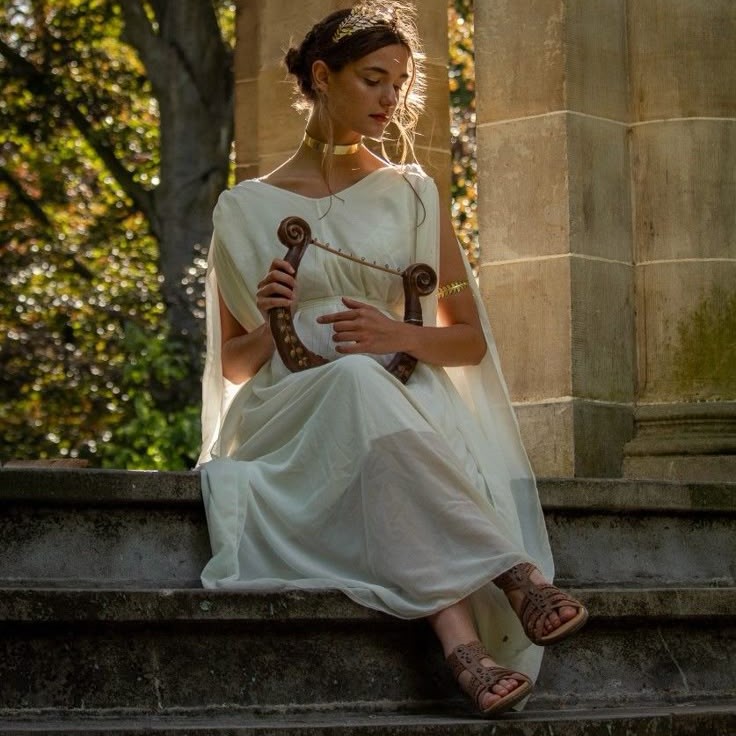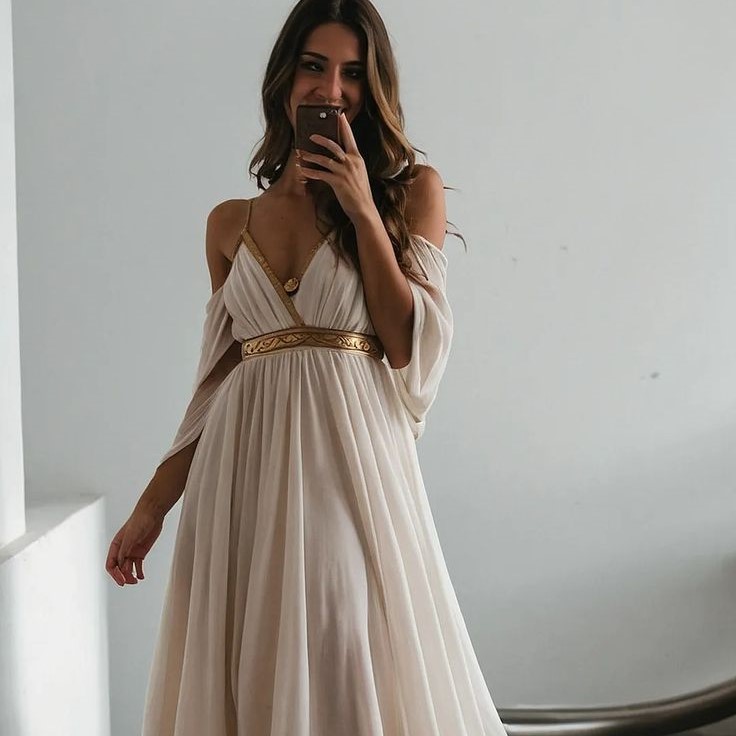Introduction
The Greek goddess dress has become a timeless symbol of elegance and class. Inspired by ancient Greek culture, these dresses exude a sense of beauty, grace, and femininity that has captivated fashion enthusiasts for centuries. Whether you are attending a themed event, a wedding, or simply wish to embrace your inner goddess, creating your own DIY Greek goddess dress is both rewarding and fun. In this article, we will outline the steps and materials needed to craft your stunning look, while exploring the rich history behind the Greek goddess.

Throughout Greek mythology, goddesses like Athena, Hera, and Aphrodite have long represented ideals of beauty, wisdom, and love. To evoke this spirit, many seek out Greek goddess dresses that utilize flowing fabrics, intricate designs, and embellishments. By taking a DIY approach, you can not only save money but also customize your dress to perfectly match your personality and style. Let’s delve into the steps needed to create your very own Greek goddess dress!
Essential Materials for Your Greek Goddess Dress
Before beginning your DIY project, it is crucial to gather all the necessary materials. Having your supplies ready will make the process smoother and more enjoyable. Here’s a list of items you will need to create a fabulous Greek goddess dress:
- Fabric: Lightweight materials such as chiffon, silk, or rayon work best for the flowy and ethereal look commonly associated with Greek goddess dresses. Consider colors that evoke the essence of the gods—whites, creams, soft pastels, or even deep jewel tones.
- Measuring Tape: Accurate measurements are vital for ensuring your dress fits well. Measure your bust, waist, and hips to determine the amount of fabric needed.
- Sewing Supplies: Gather your sewing kit, including scissors, needles, thread, pins, and a sewing machine if you have one. If you’re hand sewing, be sure to have a thimble on hand to protect your fingers.
- Embellishments: Consider decorative elements such as ribbons, beads, or sequins for added flair. These can be sewn onto the dress or used to create additional accessories.
- Patterns: Look for online patterns or sketches to guide you in creating the style you desire. You can also create your design by draping fabric on a dress form or yourself.
Having these materials on hand will enable you to create a beautiful Greek goddess dress that embodies the elegance of ancient mythology.

Measuring and Cutting Your Fabric
Once you have gathered your materials, it’s time to start the actual making of your Greek goddess dress. The first step is to measure and cut your fabric carefully to achieve the perfect fit.
Taking Accurate Measurements
- Identify Key Measurements: Begin the dress-making process by measuring three fundamental areas of your body—your bust, waist, and hips. Use a flexible measuring tape for precision.
- Determine Dress Length: Consider how long you want the dress to be. Think about whether you prefer a shorter style, such as a knee-length or tea-length dress, or if you desire a more traditional and elegant ankle-length gown.
- Fit Considerations: Remember that different styles may require different approaches to measurements. For instance, a fitted dress may need more precise measurements than a loose, flowy style.
Creating a Pattern
- Drafting Your Design: Using the measurements obtained, create a draft of your dress design. You can sketch out your ideas on paper to visualize the final product before cutting the fabric.
- Consider Basic Shapes: For certain designs, especially simple tunic-style gowns, a basic rectangle shape may suffice. Think about the silhouette you want—A-line, fitted, or empire-waist, for example.
- Seek Inspiration: Research different dress styles online or in fashion magazines. Gathering a variety of ideas can spark creativity and help you decide on specific elements for your own design.
Cutting the Fabric
- Prepare Your Workspace: Once you have your final measurements and pattern, find a spacious and flat area to lay out the fabric. Ensure that your cutting surface is clean and free from any clutter.
- Pinning the Pattern: Carefully pin the drafted pattern onto the fabric, making sure it is smoothly laid out to avoid any wrinkles or folds that might distort your cuts.
- Precision Cutting: Use fabric scissors to cut around the pattern. Take your time with this step—going slow helps ensure accuracy, which is essential for achieving a polished and professional finish.
Allowing for Seam Allowance
- Importance of Seam Allowance: While cutting out your pattern pieces, it’s crucial to include seam allowance. This extra fabric is key for ensuring that you can successfully sew the pieces together.
- Recommended Allowance: Typically, adding 1 to 2 inches around the edges will provide a comfortable margin. This extra space is important for adjustments and helps mitigate any cutting errors.
- Planning for Construction: Consider how the seam allowance may affect the overall fit and design of your dress. It’s helpful to visualize how these allowances will play into your final garment to ensure it fits as intended.
By taking accurate measurements and cutting the fabric carefully, you lay the groundwork for a stunning Greek goddess dress.

Sewing Your Greek Goddess Dress Together
With your pieces cut and prepared, it’s time to sew everything together. This creative process can be both fun and rewarding. Follow these steps to assemble your dress:
- Sewing Side Seams: Start by sewing the side seams of the dress if using separate pieces. Pin the two fabric sides together with the fabric’s right sides facing each other. Use a sewing machine or hand stitch with a straight stitch or zigzag stitch for added strength.
- Creating the Neckline and Hem: For this dress style, you’ll probably need to shape the neckline. Consider a scoop or off-the-shoulder style. Sew a hem around the neckline to avoid fraying. This same technique can be applied to the bottom hem of the dress, ensuring clean, finished edges.
- Adding a Waistband or Sash: If you wish to accentuate the waist, you can create a waistband or sash from extra fabric. Measure your waist and cut a strip of fabric accordingly, folding and sewing it to create a finished look.
- Embellishing the Dress: While the dress is being sewn, consider adding embellishments. Ribbons can be sewn around the hem or neckline, giving the dress additional character. Beads and sequins can be added for sparkle.
- Try It On: Once the sewing is complete, try the dress on to check the fit. Make any necessary adjustments to ensure it fits comfortably and looks stunning.
By following these steps, you’ll successfully sew together the main components of your Greek goddess dress, preparing it for those finishing touches.
Finishing Touches and Styling Your Costume
After successfully sewing your Greek goddess dress, it’s time to add the finishing touches. These nuances can elevate your overall look and help you embody the spirit of a Greek goddess.
- Final Hemming: Ensure the hems are sewn properly to prevent fraying. A well-finished hem creates a polished look.
- Accessorizing: Accessories play a significant role in the complete outfit. Consider adding golden or silver jewelry, such as arm cuffs, earrings, and headbands with floral designs.
- Makeup: Create a goddess-inspired makeup look with earth tones, shimmery eyeshadow, and a hint of blush. You can also adorn your face with a light dusting of glitter for a dreamy effect.
- Hairstyles: Greek goddesses are often depicted with flowing, beautiful hair. Consider curling your hair or styling it into a loose braid. You can also use hair accessories like floral crowns or elegant clips to enhance the look.
- Footwear: Pair your completed Greek goddess dress with appropriate footwear. Sandals that wrap around the ankle complement the look perfectly and maintain the historical theme.
By taking the time to style and accessorize correctly, you ensure that your Greek goddess dress not only looks incredible but also feels powerful and elegant.

Creative Ideas for Your Greek Goddess Costume
If you’re looking to put your unique spin on your Greek goddess dress, consider the following creative ideas:
- Color Variations: While traditional colors like white, gold, and green evoke classic goddess looks, don’t be afraid to experiment with bold colors like royal blue or deep red to stand out.
- Theme Integration: Consider choosing a specific goddess to inspire your costume. For example, if you align with Artemis, incorporate elements that reflect nature, such as floral patterns or animal motifs.
- Mix and Match: Don’t feel limited by a single dress. Consider mixing styles by combining a flowy skirt with a fitted top or mixing fabrics to create a layered effect.
- Add a Cloak: A long, flowing cloak can create dramatic flair and add to the ominous look of your costume. This can be ideal for colder weather.
- Interactive Props: If you’re attending a festival or event, consider carrying props like a laurel wreath or a staff that symbolizes your chosen goddess, enhancing the authenticity of your look.
By exploring these creative possibilities, you’ll create a unique Greek goddess costume that reflects your style while staying true to the theme.
Conclusion: Unleashing Your Inner Goddess
In conclusion, creating a stunning Greek goddess dress through DIY methods is an exciting and fulfilling process. By gathering the necessary materials, learning to sew your own dress, and adding personal touches, you activate your artistic skills while embracing ancient beauty.
Whether you’re preparing for a special event, a costume party, or just seeking to express your love for Greek mythology, this guide equips you with everything you need to create a memorable and eye-catching look. Embrace the confidence of a Greek goddess and step out in a costume that showcases your creativity and personality.

As you complete your Greek goddess dress, remember that embodying a goddess is about more than just appearance. It’s about channeling confidence, grace, and strength, qualities that have defined goddesses throughout history. Enjoy the transformation process, and wear your creation with pride!

